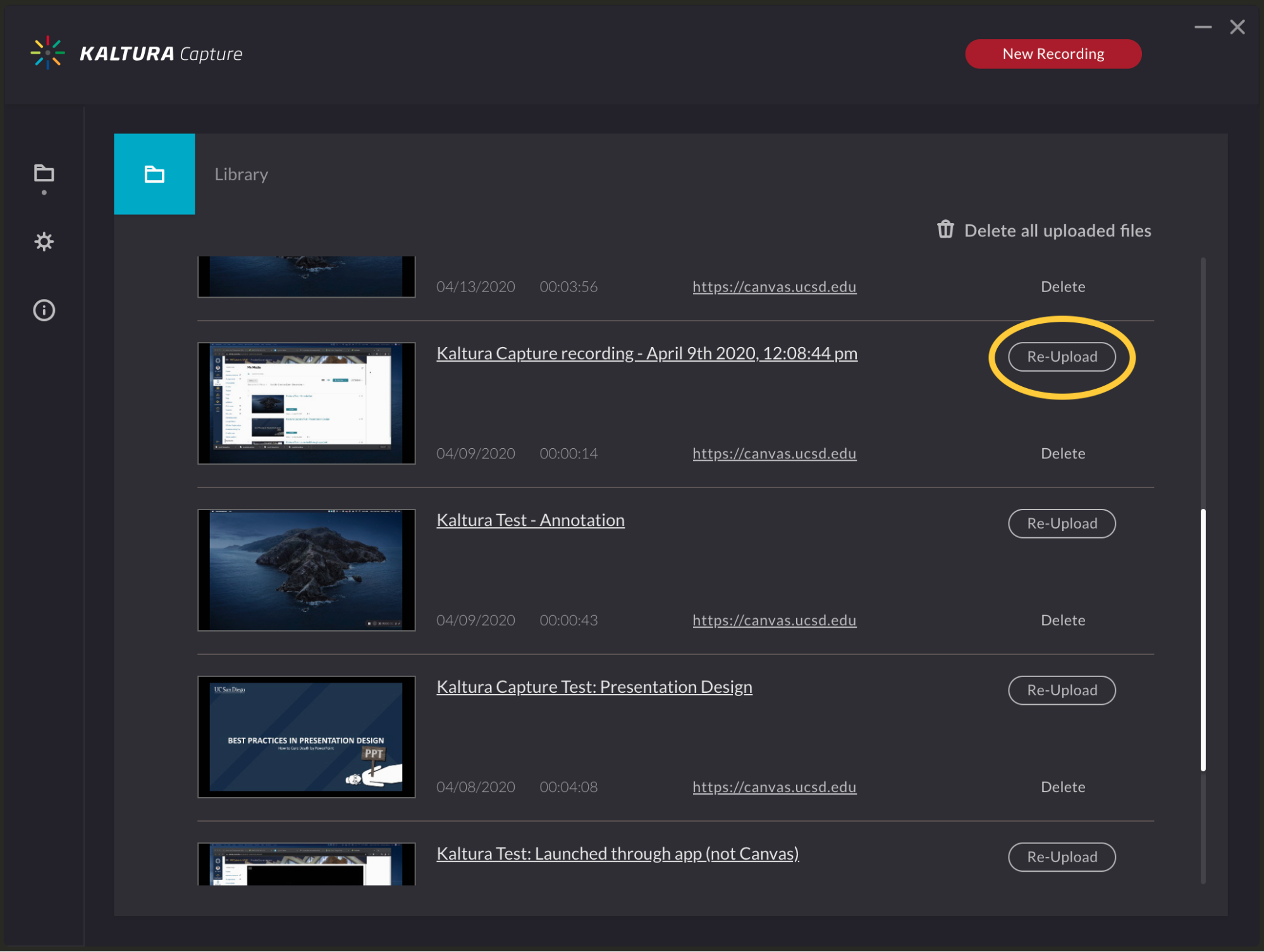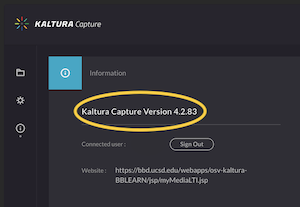Kaltura Capture Recordings Won't Upload
If you’re experiencing problems uploading your Kaltura Capture recording such that it ends up in Canvas, read below for some ideas on how to solve this.
Problem: Your Kaltura Capture recording won't upload. Maybe you clicked "save and upload" but the upload never appears to complete and doesn't end up in "My Media."
Solutions
There are several possible reasons why your Kaltura Capture recording may not upload properly. Try the solutions below, and read the detailed instructions in the drawers below as needed.
- Try again
- Update Kaltura Capture
- Check your upload speed
- Disconnect from any VPN
- Force Kaltura Capture to Re-Upload
- If nothing works, contact us kaltura@ucsd.edu and provide us some information
Try Again
Try the simplest approach before diving into more complicated solutions by leveraging Kaltura Capture's "re-upload" feature. You may want to reboot your computer before you try, just to make sure your computer has a "fresh start," so to speak.
- Open Kaltura Capture.
- Click "Manage" below the Kaltura logo on the right side of the application.

- Ensure that the folder icon is selected on the left side of the window. Locate the video you want to re-upload, and click the "Re-Upload" button. Be sure not to close Kaltura Capture until the upload has completed.

Update Kaltura Capture
Make sure that Kaltura Capture is fully updated.

- Visit https://knowledge.kaltura.com/help/kaltura-capture-release-notes. Take note of the latest version of Kaltura Capture.
- Launch Kaltura Capture.
- Click "Manage" on the right side of the application bar.
- Click the little "i" on the left side of the window.
- Note what version of Kaltura Capture you're running. If your version of Kaltura Capture is older than the current version (i.e. a lower number), you should install a newer version. Follow the additional steps below.
- Within Canvas, click "My Media" in the left navigation.
- Click the "Add New" button near the top-right of the screen and select "Kaltura Capture."
Check Your Upload Speed
Kaltura Capture is an offline application until you finish your recording and elect to upload it to the cloud. Presumably, your internet speeds shouldn't play a strong role in getting your recordings into Canvas. (That is, even if it's slow, it should make it there eventually.)
That said, we generally recommend that you have upload speeds of at least 1 mbps (1 megabit per second, or about 125 kilobytes per second). If you have a long recording and slow internet speeds, it's possible that your connection will time out. Try searching for a bandwidth speed test online and see what kind of upload speeds you have. If they're particularly slow, try to upload your videos on a network with faster speeds; going to campus might be a good option.
If you experience the same issues, or if you have robust bandwidth, review our other possible solutions.
Disconnect from any VPN
Force Kaltura Capture to Re-Upload
[Thanks to Melinda Kraft for her adapted tutorial below.]
You may encounter the issue that you are unable to find your Kaltura Capture recording in your Canvas course, and for some reason the recording isn't available with the application to re-upload using Kaltura Capture. Luckily, the application stores files on your computer as a backup, which won't disappear until you delete them yourself. These instructions will walk you through how to locate and manually upload these files.
Note that the instructions below are for advanced users only and should only be followed if you have few options available to you. That said, it is handy to know where your recording files are located.
How to Find Kaltura Capture Video Files on Your Computer
Windows
You have two options for how to locate your recordings:
- Option 1
- Right click on the Kaltura Capture icon on the desktop and select "Properties."
- Click the "File Location" button in the Properties window. This will open the BIN folder, which is a level deeper than you need.
- In the file path bar, go up one folder to the Capture folder, then open the Recordings Folder.
- Option 2
- Copy/paste the following into the search bar, substituting your Windows username for [username]:
C:\Users\[username]\AppData\Local\Kaltura\Capture\Recordings
Note that you can identify your Windows username is to open the folder C:\Users and see if you see a familiar username. Alternatively, you can open the Start Menu, select "Settings," and then "Account." - Sort the list by "Date Modified" so that you can group all the files for each recording together.
- Copy/paste the following into the search bar, substituting your Windows username for [username]:
Mac
- With the "Finder" application selected/active, select "Go" at the top of your screen.
- Select "Go to Folder" from the list.
- Copy and paste the following into the text box that opens:
~/Library/Preferences/Kaltura/Capture/Recordings - Sort the list by "Date Modified" so that you can group all the files for each recording together. To do so, click the "Date" or "Date Modified" column heading in the file view to sort the list.
About Your Kaltura Capture Files
The files associated with each Kaltura Capture recording may appear to have gibberish names.

So what are you seeing here?
- .mp4 files. The .mp4 files are the recordings. If you recorded two sources (e.g. Screen and Webcam), there will be two .mp4s. You can play them locally on your computer to figure out what each video is.
- "Slides" folders. The "Slides" folders exist if you ran a PowerPoint presentation in presentation mode during your recording. Note that if you have folders like these, it means that Kaltura created chapter markers for your video.
- .json files. The .json file contains the media upload parameters for Kaltura Capture.
- .jpg files. The .jpg file is the thumbnail Kaltura generated.
We strongly recommend against deleting or renaming any files in your "Recordings" folder. The recommended method of deleting Kaltura Capture recordings is by using the Kaltura Capture Application Library View (that you can access via the "Manage" link in the Kaltura Capture recording bar), but make sure they are in your "My Media" and working as expected first.
How To Manually Upload a Single File
- Within the "Recordings" folder (see the instructions above), copy the appropriate .mp4 file and paste it to a different location on your computer, such as your desktop.
- Rename the new copy of the file to something that makes sense to you. Be sure not to remove the .mp4 extension
- Follow the steps to upload a file from your computer to Canvas, selecting the file you've copied. If you're not sure how to do this, read our tutorial on how to upload media files to Canvas.
How to Force Kaltura Capture to Re-Upload (Multiple Files)
This technique is necessary if multiple video files are necessary for the educational content of the video. If you want or need your video to have multiple streams (e.g. your video and your screen capture simultaneously), and if you're unable to locate your recording in the "Manage" section of the Kaltura Capture application, the instructions below are what you should do.
- Shut down the Kaltura Capture application on your computer.
- Windows: locate the Kaltura Capture icon in the system tray (where the clock is) by right-clicking the application icon and choosing "Quit."
- Mac: right click the application in the system toolbar and choose Quit.
- Locate the .json file with the timestamp that closely corresponds with the two source recording (see the steps above). Note that the timestamp may not exactly match the time and date of the recordings, though it should be close.
- Make a copy of the .json file just in case. Do this by copying the file and pasting it on your desktop.
- Open the original .json file with a text editor.
- Windows: Open Notepad on your computer. Click File > Open, and select the file from your "Recordings" folder. (You can see the file path in the instructions above.)
- Mac: Open TextEdit on your computer. Click File > Open, and select the file from your "Recordings" folder. (You can see the file path in the instructions above.)
- Search for the word “uploadstatus” within the code. You should see a line that reads roughly as follows:
“uploadStatus”: “uploaded”, - Replace the word "uploaded" with “manual" and be sure not to delete the quotation marks - just replace the word within.
- Delete the comma at the end of the line. The line of code should now look like this:
"uploadStatus": "manual" - Delete all the remaining lines after this one, except the last line with a closing curly brace: “}”

- Save the file.
- Relaunch Kaltura Capture.
- In the recorder that opens, click "Manage" below the Kaltura logo on the right.
- In the window that opens, scroll the list to locate the recording you just prepared by editing the .json file. It should have an active "Upload" button next to it.

- Click the "Upload" button. Be sure to wait until the upload has completed before you close Kaltura Capture.
Your video should now show up in "My Media" within Canvas. Note that it will need to process for a little while. When the processing is done, we recommend that you watch the video to ensure it looks the way you want it to.
Ultimately, the best workaround if you need your video up immediately is to follow the instructions on how to upload a single file, located in the drawer above.
If nothing works, or if you'd like some additional help, submit a support ticket to kaltura@ucsd.edu. In your email/ticket, provide the following information:
- Your computer's operating system (Windows/Mac)
- What version of Kaltura Capture you're using
- Whether you've tried to upload from a different network
- Roughly how long your Kaltura Capture recording(s) are
- Your internet upload/download speeds
- Whether you're using a VPN
- Whether you've attempted to upload the recording manually by locating your Kaltura Capture recording files and uploading them directly to Canvas
- Your upload log token
Read below on how to provide some of the information that may not be easy to determine.
How to Find Your Kaltura Capture Version
- Visit https://knowledge.kaltura.com/help/kaltura-capture-release-notes. Take note of the latest version of Kaltura Capture.
- Launch Kaltura Capture.
- Click "Manage" on the right side of the application bar.
- Click the little "i" on the left side of the window. Your version of Kaltura Capture should be near the bottom of the window.
How to Determine Your Internet Speeds
Search for a website that can provide you an Internet speed test (e.g. https://www.speedtest.net/) and let us know your upload and download speeds.
How to get Your Upload Log Token
- Open Kaltura Capture.
- Click "Manage" on the right side of the application bar.
- Click the gear icon on the left side of the window that opens ("Settings").
- At the bottom of the window, click "upload logs." The logs will upload for a bit.
- When they're done, a little window will open showing a long string of characters - the "token." Copy that and send it along in your response. (It will look something like "62e8a9e3-b047-4d69-acce-f91feab600d0.")